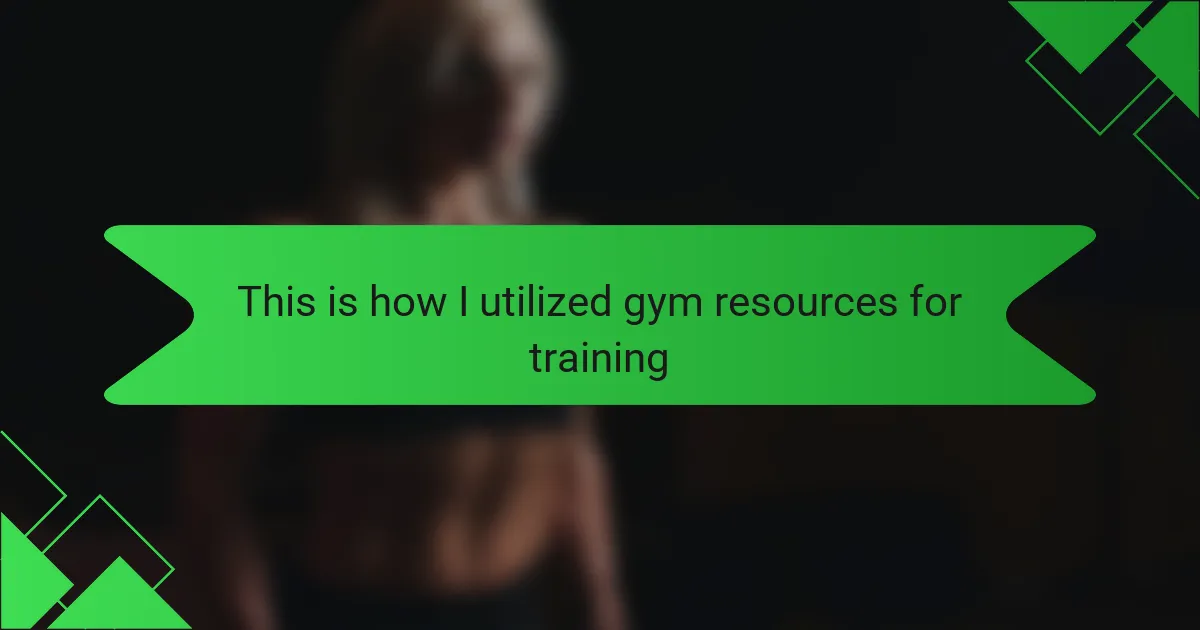Key takeaways
- Obstacle course racing requires a mix of strength, agility, and mental adaptability; mastering basic techniques is crucial for success.
- Utilizing specific gym resources, like kettlebells and battle ropes, helps build endurance and functional strength tailored for race challenges.
- Customizing workouts based on personal weaknesses and integrating strength with agility exercises enhances performance and confidence on the course.
- Tracking progress through gym tools, focusing on consistency, and varying training keeps motivation high and supports steady improvement.

Understanding obstacle course racing basics
Obstacle course racing, at its core, is more than just running—it’s a blend of strength, agility, and mental grit. From my experience, understanding this mix early on helped me focus my training effectively rather than just pounding the pavement endlessly. Have you ever wondered why some racers seem so unstoppable? It’s because they master the basics first.
What surprised me most was how technical some obstacles can be. It’s not just brute force; technique plays a huge role in saving energy and improving speed. When I first tackled a rope climb, I realized that strength alone wasn’t enough—I had to learn the right grip and body position, which completely changed how I approached training.
Obstacle course racing also demands adaptability. Conditions vary, and obstacles differ from race to race, so building a broad skill set became my priority. I found that understanding these fundamentals gave me confidence and made each race feel like a new challenge rather than an insurmountable one. Have you felt that rush when you finally conquer a tough obstacle? That’s what keeps me coming back.

Essential gym resources for obstacle training
Obstacle course racing demands a unique blend of strength, agility, and endurance, so tapping into the right gym resources can make all the difference. I remember the first time I used battle ropes and kettlebells—they challenged me in ways traditional weights never did, pushing my grip strength and functional movement to new levels.
From my experience, these gym tools specifically target the muscles and skills you’ll rely on during a race:
- Battle ropes for explosive upper-body power and endurance
- Kettlebells to build full-body strength and dynamic control
- Plyometric boxes to improve explosive leg power and jumping ability
- Pull-up bars for grip and upper-body pulling strength
- Medicine balls for rotational strength and core stability
- Rope climbing stations to simulate real race obstacles
- TRX suspension trainers for bodyweight strength and balance
Using these resources consistently helped me feel more confident tackling actual obstacles, turning gym workouts into practical race-day preparation.

Designing workouts with gym equipment
Designing workouts with gym equipment allowed me to tailor each session specifically for the unique demands of obstacle course racing. For instance, I found that combining kettlebell swings with pull-up bar exercises significantly boosted my grip strength and explosiveness. Balancing traditional machines with free weights gave me a comprehensive approach to both endurance and functional strength.
| Equipment | Benefit for Obstacle Course Racing |
|---|---|
| Kettlebells | Improves explosive power and grip strength |
| Pull-up Bar | Enhances upper body pulling strength and endurance |
| Rowing Machine | Builds cardiovascular endurance and back strength |
| Battle Ropes | Increases upper body stamina and coordination |
| Free Weights | Develops functional strength for lifting and carrying obstacles |
| Leg Press Machine | Targets leg power and stability |

Personalizing training for obstacle challenges
When I first started tailoring my workouts, I realized that a one-size-fits-all routine just didn’t cut it for obstacle racing. Each obstacle demands different muscles and movements, so I had to customize exercises to match what I’d actually face on race day. Have you ever thought about which obstacles challenge you the most? Identifying those helped me focus my training on my weak points rather than wasting energy on what I already did well.
For example, after struggling with the grip-intensive monkey bars, I began incorporating more pull-up bar variations and hanging exercises into my routine. That shift made a huge difference—I went from barely swinging across to confidently powering through. It felt like unlocking a new level of strength and confidence. Isn’t it amazing how targeted training can turn frustration into progress?
I also found that mixing different training modalities kept things fresh and prevented burnout. One week, I’d emphasize explosive movements with kettlebells and plyometric boxes; the next, I’d focus on endurance and core stability using medicine balls and rowing machines. This approach kept me adaptable, which, honestly, is crucial because no two races are ever the same. Have you experienced how variety in training fuels motivation and prepares you for anything the course throws at you?

Integrating strength and agility exercises
Integrating strength and agility exercises was a game-changer for me. I realized quickly that raw power alone wouldn’t get me over the walls or across the unstable balance beams. So, I started blending heavy lifts with quick, explosive movements like box jumps and ladder drills. Have you ever tried moving fast while under load? It’s tough, but that mix made my race transitions smoother and more efficient.
One workout that sticks in my mind combined kettlebell swings with agility cone drills. The kettlebells built my hip power and grip, while the agility work sharpened my footwork and reaction time. This combo not only boosted my confidence but also made me feel lighter on my feet, even when fatigue set in. Don’t you find that feeling of control over your body during a race incredibly rewarding?
What surprised me most was how these exercises complemented each other. Strength gave me the foundation, but agility brought the finesse. After integrating both into my routine, obstacles that once seemed impossible became manageable challenges. Have you thought about how balancing these two elements could unlock your potential? From my experience, that balance is where the magic happens.
![]()
Tracking progress using gym tools
Tracking my progress using gym tools has been a game-changer in my obstacle course racing training. I rely heavily on heart rate monitors and fitness trackers to ensure I’m pushing my limits without overdoing it. Seeing clear data motivated me to keep going, especially on days when progress felt slow.
| Gym Tool | How I Used It |
|---|---|
| Heart Rate Monitor | To keep my training intensity in the optimal zone for endurance and recovery. |
| Fitness Tracker | Tracked daily steps, calories burned, and sleep quality, helping me adjust workouts and rest. |
| Strength Machines | Measured weight increases over weeks, making my muscle gains visible and rewarding. |
| Training Apps | Logged workout routines and set reminders, keeping me accountable and consistent. |

Lessons learned from gym training experience
I realized that consistency in gym training was far more important than intensity. Early on, I pushed too hard and burned out quickly, but pacing myself allowed steady progress. The variety of equipment helped me target specific muscles critical for obstacle course racing, which kept me motivated and confident.
| Lesson | My Experience |
|---|---|
| Consistency over Intensity | Starting strong but pacing myself avoided burnout and built lasting strength. |
| Equipment Variety | Using different machines and free weights targeted key muscles, improving my race performance. |
| Mental Toughness | Gym sessions pushed me beyond comfort, helping me face race challenges with more confidence. |
